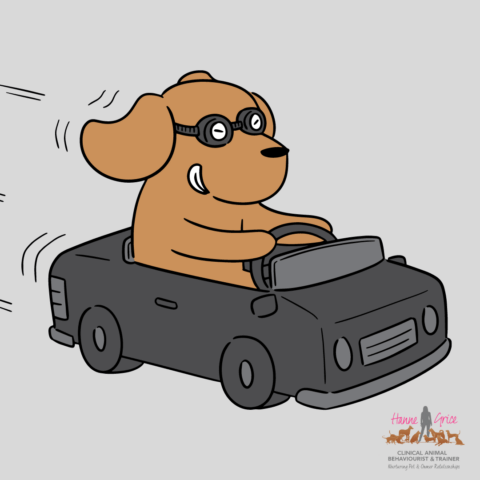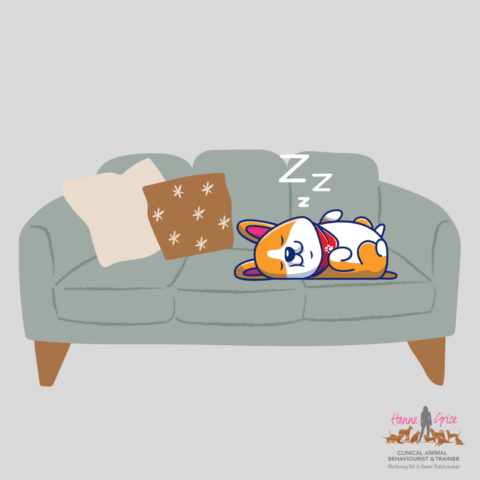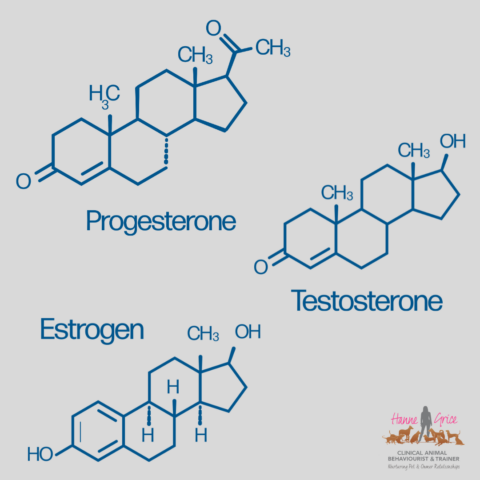
For anyone who can remember Harry Enfield’s Kevin the Teenager, this iconic 90s TV character summed up the ‘typical’ human teen—fluctuations in emotions and eating habits, high energy and enthusiasm for some things like music, masturbation and ‘risk-taking’ behaviours, coupled with periods of apathy and frustration! Certainly there are parallels with teen dogs, after all, we share many similarities including but not limited to the nervous system, and a range of emotions.
In recent years, there has been a rapid interest in the study of human adolescence. Similarly, we are seeing this interest carry over to the dog world. Although much of the literature suggests puberty in dogs is around 6 months of age to 18 months, there has been a shift. It is thought that this time period has been likely grossly under-estimated, and adolescence is more likely to last to around 24-36 months of age, depending on the individual, breed, size, personality, environmental factors, etc. And, just as humans can enter precocious puberty as early as 7 years of age, I would suggest some dogs can also experience precocious puberty, arguably from around 4 months of age. This can be exacerbated by various factors, including secondary exposure to hormone replacement theory, with puppies as young as 13 weeks showing signs of oestrus – check out my other article for more on that.
What does this all mean for owners?
For dogs, adolescence is a critical developmental stage marked by significant changes in behaviour, hormones, and brain structure. These changes can present unique challenges for dog owners and that’s why I have written this ‘ruff guide’ to teen dogs in two parts.
- Part 1 – this article aims to provide owners with an overview of adolescence and the changes they may experience with their pet.
- Part 2 – provides owners with practical strategies to support their “teen” dog through this transitional period. Or as I like to refer to it, “Learn how to ride the crest of the teenage wave amidst the storm that is puberty!”. Read Part 2 here.
PART 1 – Developmental changes in adolescent dogs
Adolescent dogs, undergo various behavioural changes as they transition from puppyhood to teens then adulthood. This can include recall falling away, increased pulling on the lead, counter-surfing, even barking at others. All of this can be confusing and frustrating for owners. Below is an overview of some of the many changes that can happen and to be aware of. Download my infographic PART 1 for a quick summary.

Behavioural changes include increased independence and risk-taking
During adolescence, dogs will have learnt the typical walks they get taken on, leading to an increased sense of confidence, and or curiosity to venture further afield. Teen dogs will also be getting taller so they can now see more of their surroundings, and they often exhibit behaviours similar to human teenagers; they may start to ‘ignore’ your calls. This is a normal part of dogs’ development as they learn to explore and try to understand their environment.
And, with this comes learning experiences – teen dogs may have learnt that chasing wildlife in the garden is fun, so this starts to present on walks. They may have learnt that running over to another dog might lead to some play. Research highlights this period as a time when owners see a decrease in general obedience and increased risk-taking behaviours (Bray et al., 2017).

Social dynamics can alter
Other behaviours you may spot are your teen dog’s preferences for others may shift. Your dog might become more interested in other dogs or unfamiliar people depending on their previous experiences in such situations or appear to take a dislike to certain individuals or situations. Just like human teens, puberty brings with it the onset of juvenile shyness, it’s a time where there is a higher risk of anxiety-related problems to start to appear. Things that never previously seemed to be a problem to the owner, can now be a big issue for adolescent pooches. For example, many entire teens are like a walking testicle – sending out a huge amount of smells to others thanks to increasing sex hormones! This can get them into trouble when encountering a neutered, nervous or older dog, and may result in the teen dog getting ‘grumped’ at (e.g., barked, snapped, lunged at, etc.).
Such experiences can soon teach our vulnerable teen dogs, that other dogs are scary and this may contribute to them then barking upon sight of another. To the other, this behaviour, may seem odd and sudden. So, it is important to monitor your dog’s interactions with others across the board, encourage frequent positive interruptions to keep arousal levels in check, and to ensure any encounters the dog has, remain positive and consistent. This can be easily fulfilled by rewarding them when another dog appears, or when another potters by; teen dogs do not need to sniff bums and play with every dog they encounter. However, do continue to maintain regular contact with any of their dog friends, walk with others they know and interact well with, to enhance learning and nurture dog social bonds.

Energy levels fluctuate, and pain/discomfort is experienced
Adolescent dogs can have erratic energy levels. You might observe bursts of high energy followed by periods of lethargy. These fluctuations are due to the changes happening in their bodies and minds. From around 6 months onwards, many owners may also reduce feeds down to twice a day, any training classes they did as a puppy have likely tailed off, and although the teen dog is a much-loved member of the family, the dog may no longer have the focus on them as they did as a puppy. This can impact the frequency, quality and type of one-to-one interactions they receive daily. All this means teen dogs, just like young humans, get very hungry, want to snack throughout the day, they need plenty of enrichment, and positive interactions with loved ones otherwise they can find their own entertainment which might be inappropriate such as digging up the garden, and teen dogs need quality, uninterrupted sleep.
During the 7-10 months of age period, dogs will also typically encounter a second phase of teething, and females can start to feel uncomfortable with the onset of their first season. The shifting adult teeth, and back molars pushing through, coupled with a swollen vulva/sore tummy, or testicles shifting/remaining undescended, plus hormonal changes, hunger and alterations in sleep patterns, can all lead to teen dogs having lowered tolerance and exhibiting a range of frustration-related behaviours, including but not limited to increased vocalisations, jumping up, mounting/humping, guarding, etc.

Hormonal changes
Hormonal surges are triggered as dogs enter puberty – this can influence their behaviour. For males, testosterone levels increase, leading to an increased likelihood to urinate on or up objects and structures. For both males and females, they may show an increased intensity in sniffing, seeking, wandering, even escaping, or pulling on lead in order to get to scents and others, as well as being appearing ‘unsettled’. For example, some teen dogs I have worked with may start to vocalise in the middle of the night, where previously, the owners have reported them as being fine when alone. Upon discussion with the owners (and having ruled out factors such as health, security lights disturbing them or the clicking of the boiler, and others disturbing sleep, etc.), these dogs may be crated or penned with lots of cosy blankets. Sex hormones can lead to rising body temperatures – think ‘hot flushes’. In my experience, such vocalisations can occur where the dogs cannot leave the crate/pen for cooler areas and flooring. By adjusting the bedding and sleeping area, this can significantly improve night-times for many of my teen dog clients.
For female dogs, they tend to experience their first oestrus cycle from around 7 months onwards and this can lead to all sorts of changes in behaviour – some may be subtle, but other behaviours can be overt. This may include lethargy, needing to be closer to the owner, collecting items and or guarding them, being sensitive to touch, less tolerant of other dogs coming close to them, or conversely very bold with others, and even increases in vocalisations.
Neurological changes
Significant changes occur in the brain’s structure and function during adolescence. The teen dog’s immature limbic system and prefrontal cortex, responsible for decision-making and impulse control, continue to develop through to adulthood (around 3 years of age). This ongoing development can result in impulsive behaviours and a lack of self-control.
It is crucial to understand that your dog is not being deliberately disobedient but is going through natural brain changes. The human adolescent brain takes time to evolve its capability to organise, regulate impulses, and weigh risks and rewards; such changes make adolescents highly vulnerable to risk-taking behaviour (Arain et al., 2013). Consequently, the human brain does not level out until around 25 years of age. As children, teens, and young adults, our brains are wired for maximum absorption, although the brain has yet to develop the areas of the brain that are optimised for higher-level understanding. As humans develop our brains into the adult form, we transition from being optimised for input to being optimised for understanding. That is why, as Dr Ritvo (2013) puts it “The adult’s capacity for understanding is why many find they have a greater ability to understand the writings of Shakespeare that may have stumped them as a teen.”

It’s the same for our canine friends, too; it takes significant time for dogs’ prefrontal cortex (the thinking part of the brain) to match up, in terms of grey matter, with the hindbrain – that almost unthinking part responsible for survival. Research indicates that brain maturation timelines and cognitive abilities can vary widely among breeds. Larger breeds, such as Great Danes, often mature more slowly than smaller breeds like Terriers, affecting training approaches and behavioural expectations. Typically, the maturation of the brain’s neural architecture complete around 24-36 months of age, this includes areas responsible for advanced cognitive functions and social behaviour.
Until this time, inhibitory hormones like gamma-aminobutyric acid (GABA), are not fully developed, and this leads to heightened impulsivity and risk-taking behaviours (Blakemore and Robbins, 2012). GABA plays a crucial role in regulating behaviour by dampening neuronal activity; during adolescence, the incomplete development of these hormones means teen dogs can struggle with self-regulation, making them more prone to displaying spontaneous, less controlled behaviours (Mills et al., 2020). Therefore, teen dogs can have more extreme reactions to things that did not previously worry them.
The adolescent brain is also highly plastic, meaning it is still developing and can be shaped by experiences. This continues throughout their life, however, this adolescence is a particular period where owners should be continuing their positive reinforcement-based training. Because this enables you to rebuild any foundation behaviours that typically fall backwards, like recall, and helps you reinforce all the behaviours you love your dog doing and want repeated, such as staying calm around others. By continuing to hone your dog’s learning and practicing their skills, you will be providing your teen dog with the consistency needed to successfully navigate this tricky time.
Key take-aways
Adolescence in dogs is a time of significant change and development. By understanding the behavioural, hormonal, and neuroscientific changes that occur during this stage, dog owners can better support their teen pets. Consistent training, socialisation, adequate exercise, and a supportive environment are key to helping adolescent dogs navigate this transitional period successfully. Patience and understanding are crucial, as this phase, while challenging, is temporary and can set the foundation for a well-behaved and well-adjusted adult pooch.
For specific advice on what you can do to support your dog during their teens, check out my Part 2 of this Ruff Guide to Dog Teens, dropping in the next week.
References
- Arain, M., Haque, M., Johal, L., Mathur, P., Nel, W., Rais, A., Sandhu, R., Sharma, S. (2013) ‘Maturation of the adolescent brain.’ Neuropsychiatric Disease and Treatment. 9, pp. 449-61.
- Blakemore, S.J. and Robbins, T.W. (2012) ‘Decision-making in the adolescent brain’, Nature Neuroscience, 15(9), pp. 1184-1191.
- Bray, E.E., Sammel, M.D., Seyfarth, R.M. et al. (2017) ‘Temperament and problem solving in a population of adolescent guide dogs.’ Animal Cognition 20, pp. 923–939.
- Maclean, E.L., Gesquiere, L.R., Gruen, M.E., Sherman, B.L., Martin, W.L. and Carter, C.S. (2019) ‘Endocrine changes in dog puberty and their association with aggression and territoriality’, Hormones and Behavior, 108, pp. 85-92.
- Mills, D.S., Karagiannis, C.I. and Zulch, H. (2020) ‘Stress—Its effects on health and behavior: A guide for practitioners’, Veterinary Clinics of North America: Small Animal Practice, 50(4), pp. 749-763.
- Ritvo , E. (2013) Parenting and the amazing teen brain part 1, Psychology Today. Available at: https://www.psychologytoday.com/ie/blog/vitality/201306/parenting-and-the-amazing-teen-brain-part-1 (Accessed: 28 May 2024).
Learn more about our classes

Get Hanne's book, clothing and more
Hanne has a number of publications including her book Playing With Your Dog to help owners work out the games that are best suited for their pet to play throughout his life, from puppyhood to old age, available from Amazon. Check out Hanne's range of contemporary casuals The Collection – for pet lovers made from recyclable, organic materials that are sustainably sourced.

